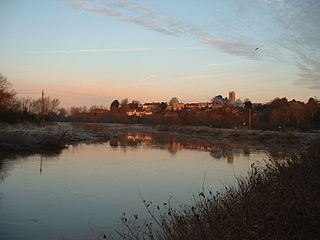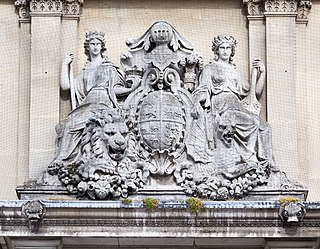

Vincent Stuckey (24 March 1771 - 8 May 1845) was a merchant and banker of Somerset and Gloucestershire whose note-issue in his heyday was the largest in England and Wales except for the Bank of England itself.


Vincent Stuckey (24 March 1771 - 8 May 1845) was a merchant and banker of Somerset and Gloucestershire whose note-issue in his heyday was the largest in England and Wales except for the Bank of England itself.
Stuckey was born at Langport on 24 March 1771. [1]
Stuckey was a partner in S & G Stuckey & Co. (later Stuckey's Banking Co.) from 1807 to 1845. In his heyday, his note-issue was the largest in England and Wales except for the Bank of England itself. [2]
Stuckey died at Langport on 8 May 1845. [1]

The Bank of England is the central bank of the United Kingdom and the model on which most modern central banks have been based. Established in 1694 to act as the English Government's banker, and still one of the bankers for the Government of the United Kingdom, it is the world's eighth-oldest bank. It was privately owned by stockholders from its foundation in 1694 until it was nationalised in 1946 by the Attlee ministry.

Sterling banknotes are the banknotes in circulation in the United Kingdom and its related territories, denominated in pounds sterling.

The Bank of Scotland plc is a commercial and clearing bank based in Edinburgh, Scotland. With a history dating to the 17th century, it is the fifth-oldest extant bank in the United Kingdom, and is the only commercial institution created by the Parliament of Scotland to remain in existence. It was one of the first banks in Europe to print its own banknotes, and it continues to print its own sterling banknotes under legal arrangements that allow Scottish banks to issue currency.

Lloyds Bank plc is a British retail and commercial bank with branches across England and Wales. It has traditionally been considered one of the "Big Four" clearing banks. Lloyds Bank is the largest retail bank in Britain, and has an extensive network of branches and ATMs in England and Wales and offers 24-hour telephone and online banking services. As of 2012 it has 16 million personal customers and small business accounts.

Langport is a small town and civil parish in Somerset, England, 5 miles (8 km) west of Somerton in the South Somerset district. The parish, which covers only part of the town, has a population of 1,081. Langport is contiguous with Huish Episcopi, a separate parish that includes much of the town's outskirts.
J.P. Morgan & Co. was a commercial and investment banking institution founded by J. P. Morgan in 1871. The company was a predecessor of three of the largest banking institutions in the world — JPMorgan Chase, Morgan Stanley, and Deutsche Bank — and was involved in the formation of Drexel Burnham Lambert. The company is sometimes referred to as the "House of Morgan" or simply "Morgan".

National Provincial Bank was a British retail bank which operated in England and Wales from 1833 until 1970 when it was merged into the National Westminster Bank. It continued to exist as a dormant non-trading company until 2016 when it was voluntarily struck off the register and dissolved.

Westminster Bank was a British retail bank which operated in England and Wales from 1834 until its merger into the National Westminster Bank in 1970; it continued to exist as a dormant registered non-trading company until 4 July 2017 when it was dissolved. Considered one of the Big Five, it expanded during the nineteenth and twentieth centuries and took over a number of smaller banking companies.

The Bank Charter Act 1844, sometimes referred to as the Peel Banking Act of 1844, was an Act of the Parliament of the United Kingdom, passed under the government of Robert Peel, which restricted the powers of British banks and gave exclusive note-issuing powers to the central Bank of England. It is one of the Bank of England Acts 1694 to 1892.

The Royal Bank of Scotland is a major retail and commercial bank in Scotland. It is one of the retail banking subsidiaries of NatWest Group, together with NatWest and Ulster Bank. The Royal Bank of Scotland has around 700 branches, mainly in Scotland, though there are branches in many larger towns and cities throughout England and Wales. The bank is completely separate from the fellow Edinburgh-based bank, the Bank of Scotland, which pre-dates the Royal Bank by 32 years. The Royal Bank of Scotland was established in 1724 to provide a bank with strong Hanoverian and Whig ties.

Messrs. Drummond is a formerly independent private bank that is now owned by NatWest Group. The Royal Bank of Scotland incorporating Messrs. Drummond, Bankers is based at 49 Charing Cross in central London. Drummonds is authorised as a brand of The Royal Bank of Scotland by the Prudential Regulation Authority.

The Manchester and Liverpool District Bank was formed in 1829 and it became one of the leading provincial joint stock banks; its name was shortened to District Bank in 1924. The Bank was acquired by the National Provincial Bank in 1962 but kept its identity until the latter’s merger with Westminster Bank.

Parr's Bank Limited was a bank that existed from 1782 to 1918. It was founded as Parr & Co. in Warrington, then in the county of Lancashire in the United Kingdom. In 1918 it was acquired by London County and Westminster Bank, and it was thus one of the predecessors of NatWest Group.
Banknotes of Scotland are the banknotes of the pound sterling that are issued by three Scottish retail banks and in circulation in Scotland. The issuing of banknotes by retail banks in Scotland is subject to the Banking Act 2009, which repealed all earlier legislation under which banknote issuance was regulated, and the Scottish and Northern Ireland Banknote Regulations 2009. Currently, three retail banks are allowed to print notes for circulation in Scotland: Bank of Scotland, Royal Bank of Scotland, and Clydesdale Bank.
Williams & Glyn's Bank Limited was established in London in 1970, when the Royal Bank of Scotland merged its two subsidiaries in England and Wales, Williams Deacon's Bank Ltd. and Glyn, Mills & Co. In 1985, Williams & Glyn's was fully absorbed into the Royal Bank of Scotland and ceased to trade separately. Royal Bank of Scotland Group PLC was renamed NatWest Group in 2020.
National Westminster Bank, commonly known as NatWest, is a major retail and commercial bank in the United Kingdom. It was established in 1968 by the merger of National Provincial Bank and Westminster Bank. In 2000, it became part of The Royal Bank of Scotland Group, which was re-named NatWest Group in 2020. Following ringfencing of the Group's core domestic business, the bank became a direct subsidiary of NatWest Holdings; NatWest Markets comprises the non-ringfenced investment banking arm.

The Royal Bank of Scotland £20 note is a banknote of the pound sterling. It is the third largest denomination of banknote issued by The Royal Bank of Scotland. The current polymer note, first issued in 2020, bears the image of Catherine Cranston on the obverse and a vignette depicting a pair of Red Squirrels on the reverse.

The Royal Bank of Scotland £50 note is a banknote of the pound sterling. It is the second largest denomination of banknote issued by the Royal Bank of Scotland. The current cotton note, first issued in 2005 bears an image of Lord Ilay, one of the founders of the bank, on the obverse and a vignette of Inverness Castle on the reverse.

The Royal Bank of Scotland £100 note is a banknote of the pound sterling. It is the largest denomination of banknote issued by The Royal Bank of Scotland. The current cotton note, first issued in 1987, bears an image of Lord Ilay, one of the founders of the bank, on the obverse, and a vignette of Balmoral Castle on the reverse.
Philip Thomas Saunders FRPSL was a British banker and philatelist. He started in banking before the First World War but his career was interrupted by service in the Royal Flying Corps during the conflict. Returning to banking after the war, he published a history of Stuckey's Bank in 1928, working for banks that ultimately became today's National Westminster, before retiring in 1959.